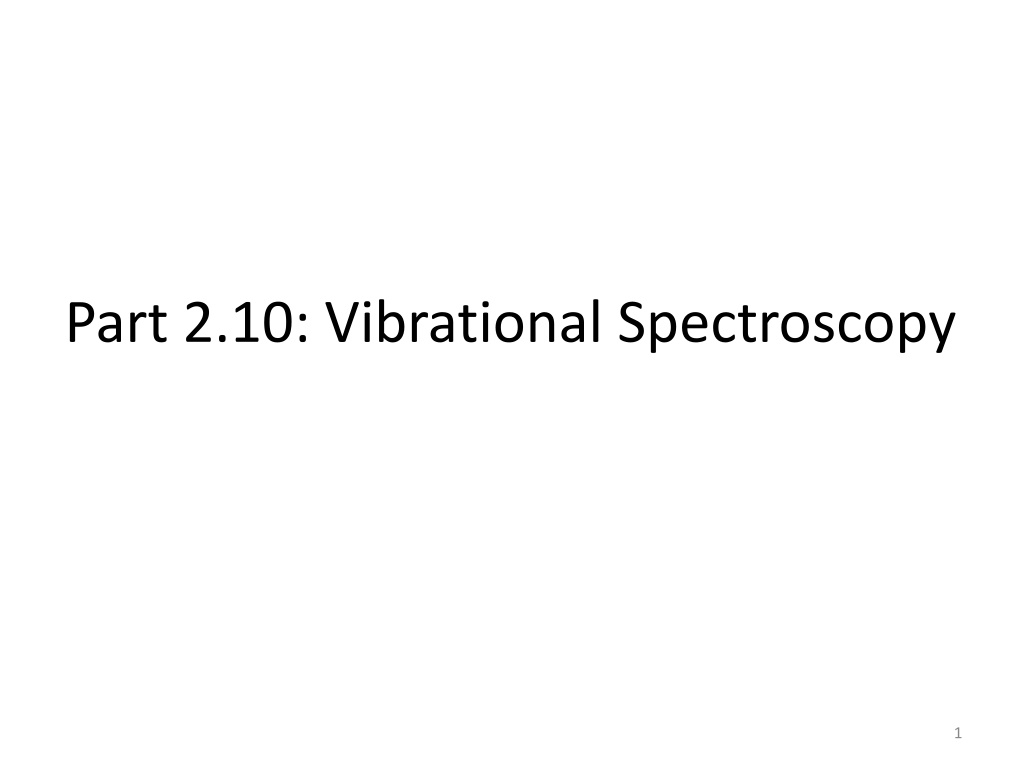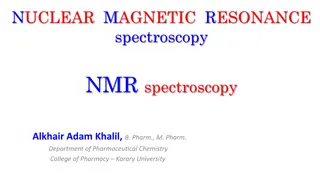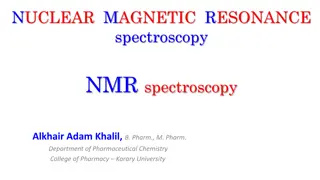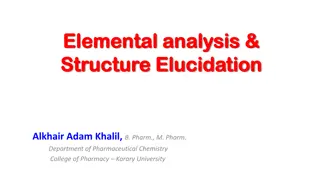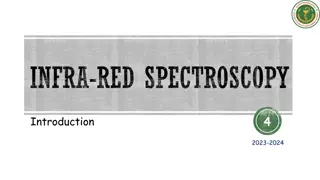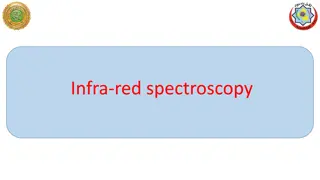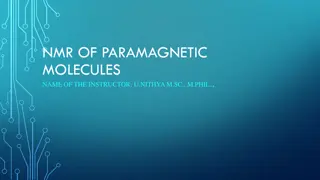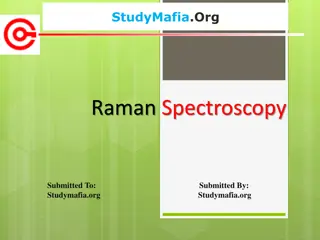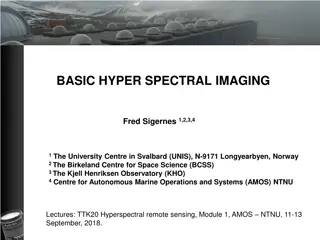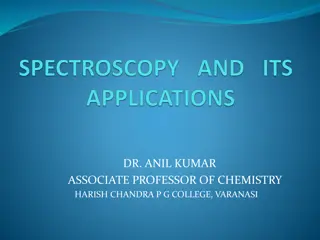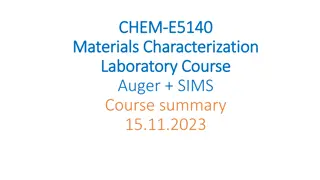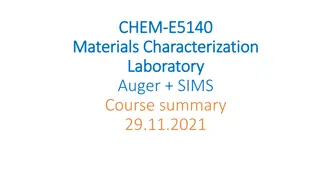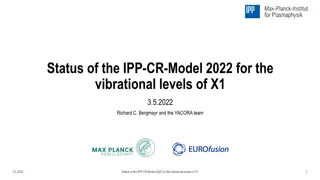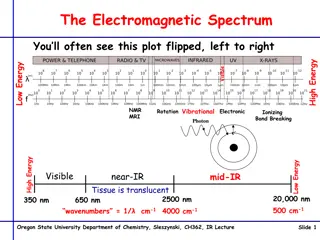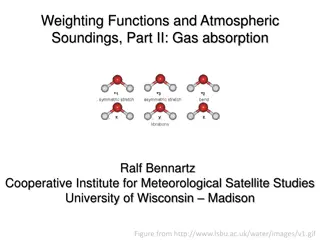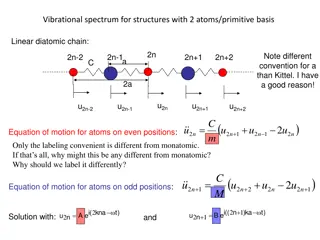Understanding Molecular Vibrations in Vibrational Spectroscopy
Explore the world of molecular vibrations and their significance in vibrational spectroscopy. Learn about the different types of vibrations in diatomic and triatomic molecules, the concept of degrees of freedom, and how atoms change positions to create varying bond lengths and angles. Discover the role of Hooke's Law in molecular vibrations and the implications for understanding molecular structures.
Download Presentation

Please find below an Image/Link to download the presentation.
The content on the website is provided AS IS for your information and personal use only. It may not be sold, licensed, or shared on other websites without obtaining consent from the author. Download presentation by click this link. If you encounter any issues during the download, it is possible that the publisher has removed the file from their server.
E N D
Presentation Transcript
Single Atom Vibration- Atoms of a molecule changing their relative positions without changing the position of the molecular center of mass. No Vibartion It takes two to vibrate No Rotation A point cannot rotate Translation Can move in x, y, and/or z 3 Degrees of Freedom (DOF) 0 Vibrations 2
Diatomic Molecule 2 atoms x 3 DOF = 6 DOF Translation 6 DOF - 3 Translation - 2 Rotation 1 Vibration Rotation For a Linear Molecule # of Vibrations = 3N-53
Linear Triatomic Molecule 3 atoms x 3 DOF = 9 DOF 9 DOF - 3 Translation - 2 Rotation 4 Vibration For a Linear Molecule # of Vibrations = 3N-5 Argon (1% of the atmosphere)- 3 DOF, 0 Vibrations 4
Nonlinear Triatomic Molecule 3 atoms x 3 DOF = 9 DOF 3 Translation 3 Rotation Linear non-linear 5
Nonlinear Triatomic Molecule 3 atoms x 3 DOF = 9 DOF Transz Rz 9 DOF - 3 Translation - 3 Rotation 3 Vibration Transy Rx Transx Ry For a nonlinear Molecule # of Vibrations = 3N-6 6
Nonlinear Triatomic Molecule 3 atoms x 3 DOF = 9 DOF 9 DOF - 3 Translation - 3 Rotation 3 Vibration For a nonlinear Molecule # of Vibrations = 3N-6 7
Molecular Vibrations Atoms of a molecule changing their relative positions without changing the position of the molecular center of mass. Even at Absolute Zero! Center of Mass In terms of the molecular geometry these vibrations amount to continuously changing bond lengths and bond angles. Reduced Mass 8
Molecular Vibrations Hooke s Law k = force constant x = distance Assumes- It takes the same energy to stretch the bond as to compress it. The bond length can be infinite. 9
Molecular Vibrations Vibration Frequency ( ) Related to: Stiffness of the bond (k). Atomic masses (reduced mass, ). 10
Molecular Vibrations Classical Spring Quantum Behavior Sometimes a classical description is good enough. Especially at low energies. 11
6 Types of Vibrational Modes Assymmetric Stretch Wagging Symmetric Stretch Scissoring Rocking Twisting 12
Vibrations and Group Theory What kind of information can be deduced about the internal motion of the molecule from its point-group symmetry? Each normal mode of vibration forms a basis for an irreducible representation of the point group of the molecule. 1) Find number/symmetry of vibrational modes. 2) Assign the symmetry of known vibrations. 3) What does the vibration look like? 4) Find if a vibrational mode is IR or Raman Active. 13
1) Finding Vibrational Modes 1. Assign a point group 2. Choose basis function (three Cartesian coordinates or a specific bond) 3. Apply operations -if the basis stays the same = +1 -if the basis is reversed = -1 -if it is a more complicated change = 0 4. Generate a reducible representation 5. Reduce to Irreducible Representation 6. Subtract Translational and Rotational Motion 14
Example: H2O 1. 2. 3. Assign a point group Choose basis function Apply operations -if the basis stays the same = +1 -if the basis is reversed = -1 -if it is a more complicated change = 0 C2v point group Basis: x1-3, y1-3 and z1-3 Atom 1: x1 = 1 Atom: 1 2 3 y1 = 1 z1 = 1 E: 3 + 3 + 3 = 9 Atom 2: x2 = 1 E y2 = 1 z2 = 1 Atom 3: x3 = 1 y3 = 1 z3 = 1 15
Example: H2O 1. 2. 3. Assign a point group Choose basis function Apply operations -if the basis stays the same = +1 -if the basis is reversed = -1 -if it is a more complicated change = 0 C2v point group Basis: x1-3, y1-3 and z1-3 Atom 1: x1 = 0 Atom: 1 2 3 y1 = 0 z1 = 0 E: 3 + 3 + 3 = 9 Atom 2: x2 = -1 C2: 0 + -1 + 0 = -1 C2 y2 = -1 z2 = 1 Atom 3: x3 = 0 y3 = 0 z3 = 0 16
Example: H2O 1. 2. 3. Assign a point group Choose basis function Apply operations -if the basis stays the same = +1 -if the basis is reversed = -1 -if it is a more complicated change = 0 C2v point group Basis: x1-3, y1-3 and z1-3 Atom 1: x1 = 0 Atom: 1 2 3 y1 = 0 z1 = 0 E: 3 + 3 + 3 = 9 Atom 2: x2 = 1 C2: 0 + -1 + 0 = -1 xz y2 = -1 z2 = 1 xz: 0 + 1 + 0 = 1 Atom 3: x3 = 0 y3 = 0 z3 = 0 17
Example: H2O 1. 2. 3. Assign a point group Choose basis function Apply operations -if the basis stays the same = +1 -if the basis is reversed = -1 -if it is a more complicated change = 0 C2v point group Basis: x1-3, y1-3 and z1-3 Atom 1: x1 = -1 Atom: 1 2 3 y1 = 1 z1 = 1 E: 3 + 3 + 3 = 9 Atom 2: x2 = -1 C2: 0 + -1 + 0 = -1 yz y2 = 1 z2 = 1 xz: 0 + 1 + 0 = 1 Atom 3: x3 = -1 yz: 1 + 1 + 1 = 3 y3 = 1 z3 = 1 18
Example: H2O 1. 2. 3. Assign a point group Choose basis function Apply operations -if the basis stays the same = +1 -if the basis is reversed = -1 -if it is a more complicated change = 0 Generate a reducible representation C2v point group Basis: x1-3, y1-3 and z1-3 4. Atom: 1 2 3 E: 3 + 3 + 3 = 9 C2: 0 + -1 + 0 = -1 -1 9 1 3 xz: 0 + 1 + 0 = 1 yz: 1 + 1 + 1 = 3 19
Example: H2O 1. 2. 3. Assign a point group Choose basis function Apply operations -if the basis stays the same = +1 -if the basis is reversed = -1 -if it is a more complicated change = 0 Generate a reducible representation Reduce to Irreducible Representation C2v point group Basis: x1-3, y1-3 and z1-3 4. 5. -1 9 1 3 Irreducible Rep. 20 Reducible Rep.
Example: H2O Decomposition/Reduction Formula order (h) h = 1 + 1 + 1 + 1 = 4 -1 1 3 9 1 4 [ =12 ] (1)(9)(1) = 3 + (1)(-1)(1) + (1)(1)(1) + (1)(3)(1) aA1 = 4 = 3A1 + A2 + 2B1 + 3B2 21
Example: H2O 1. 2. 3. Assign a point group Choose basis function Apply operations -if the basis stays the same = +1 -if the basis is reversed = -1 -if it is a more complicated change = 0 Generate a reducible representation Reduce to Irreducible Representation Subtract Rot. and Trans. C2v point group Basis: x1-3, y1-3 and z1-3 3 atoms x 3 DOF = 9 DOF 3N-6 = 3 Vibrations 4. 5. 6. = 3A1 + A2 + 2B1 + 3B2 Trans= A1 + B1 + B2 Rot= A2 + B1 + B2 Vib= 2A1 + B2 22
Example: H2O 1. 2. 3. Assign a point group Choose basis function Apply operations -if the basis stays the same = +1 -if the basis is reversed = -1 -if it is a more complicated change = 0 Generate a reducible representation Reduce to Irreducible Representation Subtract Rot. and Trans. C2v point group Basis: x1-3, y1-3 and z1-3 4. 5. 6. Vibration= 2A1 + B2 23
Example: H2O 1. 2. 3. 4. Start with a drawing of a molecule Draw arrows Use the Character Table Predict a physically observable phenomenon C2v point group Basis: x1-3, y1-3 and z1-3 Vibrations= 2A1 + B2 B2 A1 All three are IR active but that is not always the case. A1 24
Vibrations and Group Theory 1) Find number/symmetry of vibrational modes. 2) Assign the symmetry of known vibrations. 3) What does the vibration look like? 4) Find if a vibrational mode is IR or Raman Active. 25
2) Assign the Symmetry of a Known Vibrations Bend Stretch Stretch Vibrations= 2A1 + B2 Bend 1. 2. 3. Assign a point group Choose basis function (stretch or bend) Apply operations -if the basis stays the same = +1 -if the basis is reversed = -1 -if it is a more complicated change = 0 Generate a reducible representation Reduce to Irreducible Representation Stretch 4. 5. 26
Example: H2O 1. 2. 3. Assign a point group Choose basis function Apply operations -if the basis stays the same = +1 -if the basis is reversed = -1 -if it is a more complicated change = 0 C2v point group Basis: Bend angle E E: 1 C2 C2: 1 xz xz: 1 yz yz: 1 27
Example: H2O 1. 2. 3. Assign a point group Choose basis function Apply operations -if the basis stays the same = +1 -if the basis is reversed = -1 -if it is a more complicated change = 0 Generate a reducible representation Reduce to Irreducible Representation C2v point group Basis: Bend angle 4. 5. 1 1 1 1 Irreducible Rep. 28 Reducible Rep.
2) Assign the Symmetry of a Known Vibrations Bend Stretch Stretch A1 Vibrations= A1 + B2 1. 2. 3. Assign a point group Choose basis function (stretch) Apply operations -if the basis stays the same = +1 -if the basis is reversed = -1 -if it is a more complicated change = 0 Generate a reducible representation Reduce to Irreducible Representation Stretch 4. 5. 29
Example: H2O 1. 2. 3. Assign a point group Choose basis function Apply operations -if the basis stays the same = +1 -if the basis is reversed = -1 -if it is a more complicated change = 0 C2v point group Basis: OH stretch E E: 2 C2 C2: 0 xz xz: 0 yz yz: 2 30
Example: H2O 1. 2. 3. Assign a point group Choose basis function Apply operations -if the basis stays the same = +1 -if the basis is reversed = -1 -if it is a more complicated change = 0 Generate a reducible representation Reduce to Irreducible Representation C2v point group Basis: OH stretch 4. 5. 2 2 0 0 Irreducible Rep. 31 Reducible Rep.
Example: H2O Decomposition/Reduction Formula order (h) h = 1 + 1 + 1 + 1 = 4 0 0 2 2 1 4 [ 4 4 ] (1)(2)(1) = 1 + (1)(0)(1) + (1)(0)(1) + (1)(2)(1) = aA1 = 4 1[ ] (1)(2)(1) = 1 + (1)(0)(-1) + (1)(0)(-1) + (1)(2)(1) = aB2 = 4 4 = A1 + B2 32
2) Assign the Symmetry of a Known Vibrations Bend Stretch Stretch A1 Vibrations= A1 + B2 3) What does the vibration look like? By Projection Operator By Inspection 33
Vibrations and Group Theory 1) Find number/symmetry of vibrational modes. 2) Assign the symmetry of known vibrations. 3) What does the vibration look like? 4) Find if a vibrational mode is IR or Raman Active. 34
3) What does the vibration look like? By Inspection = A1 + B2 1 1 1 1 1 -1 1 -1 B2 A1 35
3) What does the vibration look like? Projection Operator 1. Assign a point group 2. Choose non-symmetry basis ( r1) 3. Choose a irreducible representation (A1 or B2) 4. Apply Equation - Use operations to find new non-symmetry basis ( r1) - Multiply by characters in the irreducible representation 5. Apply answer to structure 36
3) What does the vibration look like? Projection Operator Assign a point group Choose non-symmetry basis ( r1) Choose a irreducible representation (A1) Apply Equation - Use operations to find new non-symmetry basis ( r1) - Multiply by characters in the irreducible representation 1. 2. 3. 4. C2v point group Basis: r1 For A1 E C2 xz yz 37
3) What does the vibration look like? Projection Operator 1. 2. 3. 4. Assign a point group Choose non-symmetry basis ( r1) Choose a irreducible representation (A1) Apply Equation - Use operations to find new non-symmetry basis ( r1) - Multiply by characters in the irreducible representation C2v point group Basis: r1 For A1 E C2 xz yz 38
3) What does the vibration look like? Projection Operator 1. 2. 3. 4. Assign a point group Choose non-symmetry basis ( r1) Choose a irreducible representation (B2) Apply Equation - Use operations to find new non-symmetry basis ( r1) - Multiply by characters in the irreducible representation C2v point group Basis: r1 For B2 E C2 xz yz 39
3) What does the vibration look like? Projection Operator 1. 2. 3. 4. Assign a point group Choose non-symmetry basis ( r1) Choose a irreducible representation (B2) Apply Equation - Use operations to find new non-symmetry basis ( r1) -Multiply by characters in the irreducible representation Apply answer to structure C2v point group Basis: r1 5. B2 A1 40
3) What does the vibration look like? Asymmetric Stretch Symmetric Stretch Bend A1 A1 B2 Molecular Structure + Point Group Find/draw the vibrational modes of the molecule B2 = A1 A1 Does not tell us the energy! Does not tell us IR or Raman active! 41
Vibrations of C60 1) Find number/symmetry of vibrational modes. 2) Assign the symmetry of known vibrations. 3) What does the vibration look like? 4) Find if a vibrational mode is IR or Raman Active. 42
Vibrations and Group Theory 1) Find number/symmetry of vibrational modes. 2) Assign the symmetry of known vibrations. 3) What does the vibration look like? 4) Find if a vibrational mode is IR or Raman Active. Next ppt! 46
Side note: A Heroic Feat in IR Spectroscopy C2v: 20A1 + 19B2 + 9B1 47 Kincaid et al. J . Phys. Chem. 1988, 92, 5628.
